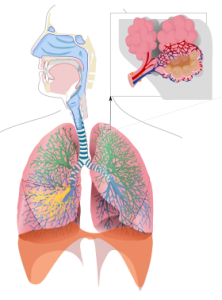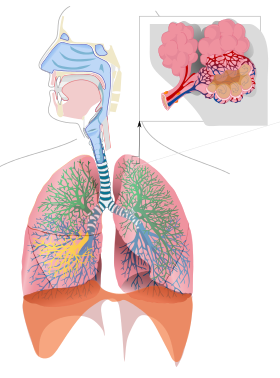Breathing for Endurance
 Breathing. It’s a simple thing. You don’t think about it much. Yet if you don’t breathe you’ll be in trouble. When you work out you breathe harder. How important is breathing to your endurance sport? Is there anything you can do to make your breathing more effective?
Breathing. It’s a simple thing. You don’t think about it much. Yet if you don’t breathe you’ll be in trouble. When you work out you breathe harder. How important is breathing to your endurance sport? Is there anything you can do to make your breathing more effective?
Why are we breathing in the first place? Because we need to bring oxygen into our bodies. Our cells need oxygen to burn fuel and create energy. The lungs are the organ in your chest cavity that bring in fresh air and oxygen. The lung are the major respiratory organ in humans. They transfer oxygen from the environment into the bloodstream and expire carbon dioxide from the blood stream back into the atmosphere.
You have two lungs, a left and a right. In most people the right is bigger than the left because the heart nestles into the left lung. The structure starts with the flexible tube that comes down from your mouth – the trachea. Then a series of increasingly smaller bronchia pathways ending in little sacs called alveoli where the respiration happens.
If you think about it logically it makes sense that smokers are out of breath. They have gummed up the works inside their lungs. The tissue doesn’t work as well because it is clogged and hardened. Smoking to get nicotine or any other drug works because it uses the same respiratory function to get the vaporized drugs into the blood stream.
The physical action of breathing is enabled by a muscle called the diaphragm. You probably have heard people encouraging breathing from the diaphragm. What is it and where is it? It’s a skeletal muscle that runs across the bottom of the thoracic cavity. When people talk about diaphragmatic or ‘belly breathing’ they mean using this muscle instead of the muscles in your chest.
Now that the 5th grade science lesson is over, what does this have to do with running and endurance sports? It depends who you talk to or listen to.
I’ll start off by saying that I have never worked with or worried about breathing cadences. I do use my breathing as an indicator of effort level and as a tool to reset my effort and we’ll talk about that later. But first let’s review those coaches who present systematic training methods based on breathing techniques.
There are coaches who put a lot of emphasis on breathing. Most notably breathing is the core of Budd Coates training program. Coates has written a lot about timing your inhales and exhales. The theory is that if you always breathe on the same foot strike it’s a form of overuse and can lead to injury. There doesn’t seem to be much enthusiasm scientifically for this theory but Budd uses breathing cadence as one of the cores of his training methodology.
Coates argues that when you exhale your diaphragm is relaxed and therefore provide less support to your core. If you have it relaxed on the same side every time you’ll get injuries on that side. If any of this seems like something you’d like to dive deeper into you can get his book about it called “Running on Air”. I’m probably not doing his thought process justice and should get him on for an interview to defend himself!
What is breathing cadence? It means simply how many foot strikes you have when you’re running during each inhale and exhale. A 2:2 breathing cadence would mean 2 foot strikes for the inhale and 2 for the exhale. This is the cadence coach Jack Daniels recommends in his training. Coates has his runners learn a 3:2 cadence so that it alternates feet.
There are also coaches who argue about whether it’s best to breathe through the mouth or nose exclusively or a little bit of both.
My caution here, looking at it from the outside, is that it looks like we are doing the same thing with breathing that we do with everything. We are separating one specific element of a system and trying to optimize it with methodologies. My view is always a bit more holistic. I think we need to understand all the pieces but work with the whole system. One might say ‘systematically’.
What can you as an average runner or athlete do to work on your breathing?
The first thing you can do is to notice it. Next time you’re out running just notice your breathing. Notice how it changes over the course of the run as you warm up. Notice how it changes as you change your effort level. Count the cadences and see what your rhythm. Is. Just take mental notes. Play around with it.
Notice how you breathe physically. Do you breathe through the mouth or through the nose or both? Does it change depending on the effort. Do you breathe with your chest or with your belly? Does that change depending on where you are in the run and your effort level.
Take your mental notebook with you and pay attention to your breathing for a couple runs and see what you learn about yourself. Maybe there is something you need to work on with your breathing or some opportunity to improve.
Have you ever finished a hard track repeat or a hill sprint and found yourself bent over, hands on thighs and gasping for air? What happened? You pushed your muscles well beyond the available oxygen supply. You essentially ran yourself out of breath. Now you’re gasping for air to get oxygen into those screaming muscles. That’s why sprinting is called anaerobic training. ‘an’ = without an ‘aerobic’ = oxygen.
Is there a way to increase your lung capacity? To make them more efficient?
There is. There are three things you can do. First you can absolutely practice strengthening your breathing mechanisms. Second you can use your form to breath more efficiently. Finally, you can integrate breathing as a tool in your training and racing.
Any consistent exercise will strengthen and increase the capacity of your lungs. You can do specific lung exercises. These typically involve inhaling very deeply, holding the breath for a 4-5 count then blowing it out. You can do resistance training by wearing a mask or simply breathing through your nose all the time. You can move to altitude! You can take up playing the tuba! Any consistent exercise that forces you to work your breath will increase your lung capacity.
I have found that swimming is a great way to exercise your breathing control and breathing cadence. Over the years, I have trained my swim cadence to be a three stroke cadence that forces me to breathe on opposite sides. This forces me to slow down my stroke and match my exertion to the available breath. It helps me swim straighter and get sighting on both sides.
Another thing to remember is that the diaphragm is a muscle. It can be strengthened and stretched like any other muscle. There are specific yoga and pilate exercises that focus specifically on strengthening the diaphragm during breathing. You might find it useful to walk through some of these simply to assess how well you are using your diaphragm and maybe add some practices to improve that.
What about form? How does form influence breathing? Good form allows for deep, diaphragmatic breathing. If you are hunched over you’re compressing that breathing area in your body. Run tall, upright, with a loose arm swing, with your shoulder open and your chin up. Breathe deeply into this good open form and you’ll have plenty of room to get your lungs expanded.
Finally, I think the most important exercise you can do with your breathing is to integrate it into your running. Breathing is part of a system, it can be both an input and a result. You can use your breathing to control your effort level and correct your state.
Here is an example; when you are out in a race or a harder workout and you notice your form is starting to degrade. The effort level feels hard. You’re teetering on the edge of systems failure that will cause you to slow down or walk. What do you do?
You need to figure out how to reset your form and effort level. Typically, I would tell you to do a systems check and clean up your form. Part of that systems check is your breathing. In most of these situations you’ll find that your breathing has become shallow and gasping. As part of the form reset the first thing I do is take a big, big, diaphragmatic breath and blow it out. I might take do these two or three times. I physically and mentally relax on the exhale.
This resets my effort level and resynchs my breath with my form. This is what I mean when I say ‘relax into the effort’. You force your breathing to be deep and easy and relax your form. You stop fighting it and relax into it. As your form, cadence and breathing synch the effort becomes sustainable again.
Try this during your next hard work out. Practice it during your training. It’s a very useful racing skill.
This takes us to our final thought. Breathing is a holistic part of your overall endurance capability. The ability to integrate your breathing with your form and effort is a big benefit in training and racing. Scott Jurek, for example talks about using his breathing as meditation during his ultra-distance runs.
That ability to integrate your breathing starts with noticing it. One great way to get good at noticing your breathing is breathing meditation. You can find 100+ breathing meditation guides and videos on youtube. It is basically just sitting quietly and focusing on your breath for a few minutes. It’s a great practice for calming your mind but also a practice for integrating your breathing.
For now, all you have to do is notice your breath. On a few of your next runs, make them ‘breath’ runs. Leave your music and podcasts at home. Just listen to your breath. See how your breath plays with your mind/body interactions.

